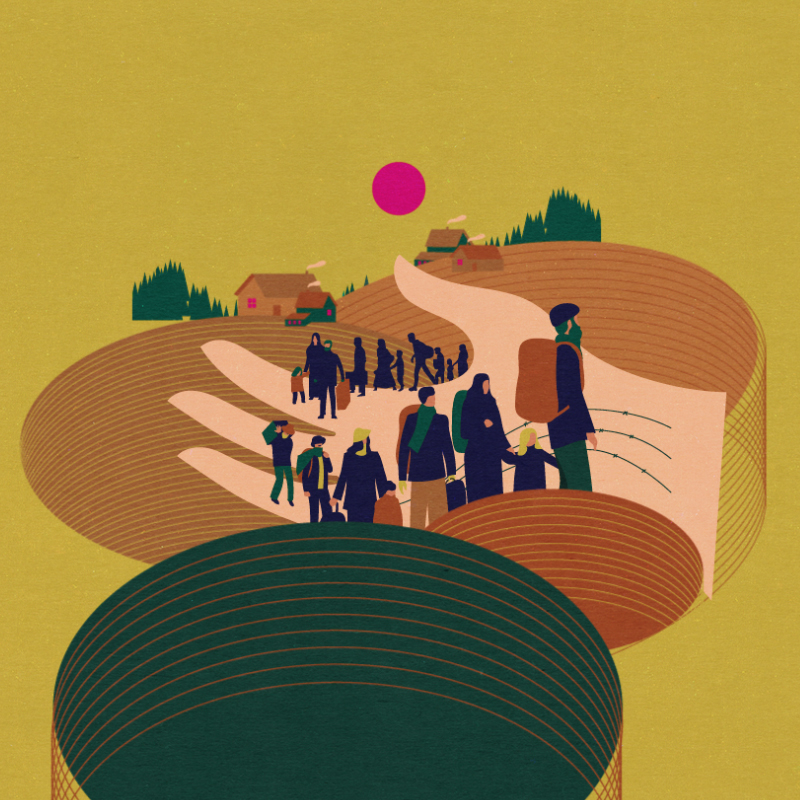Forced Migration, or When You Have To Leave Your Home
> BACK TO 100 STORIESListen to this text (Lithuanian):
Today, Lithuanians usually leave their homeland voluntarily for economic reasons – they hope to find a better paid job abroad and reach their full potential in their professional field. We call those living in a foreign country emigrants (from the word to migrate, to travel). But there were many periods in the history of Lithuania when people had to leave against their will. Forced migration, also known as forced displacement, occurs when people have to leave their homes due to a military conflict, a natural disaster, or political or religious persecution.
Lithuanians were first forced to leave their homes because of wars. The fight against the German Order took place in the territory of Lithuania in the thirteenth to fourteenth centuries: wars were ruthless in the Middle Ages – both Lithuanians and Germans burned, looted, raped and killed peaceful people living in enemy territory. As a result, residents from the coast, and later from Samogitia, the areas where most military clashes took place, began to retreat to quieter places.
However, nothing compares to the mass deportations of the First and Second World Wars and the subsequent Soviet occupation – about 1,5 million people were forced out of Lithuania in 1914–1953. During World War I (1915–1918), about 250.000 Lithuanians were forced to flee to Russia. There were many intellectuals amongst the emigrants who believed that it was possible to preserve their national identity even in exile: various societies were organised, schools were founded, and the Lithuanian press was allowed. During World War II, many Lithuanians fled to Germany to escape Soviet persecution – about 65.000 Lithuanian refugees lived in Germany in 1945. They lived in DP (displaced person) camps, therefore they were called dipukas [Eng. DPs]. There were many famous Lithuanian writers and scientists among the DPs. The camps contained Lithuanian kindergartens, primary schools, progymnasiums and gymnasiums, as well as art and sports groups, craft schools, theaters and even publishing houses. The daily life of DPs was described by Antanas Škėma, who lived in one of the camps and later emigrated to the United States, in his novel Balta Drobulė (‘White Shroud’, (1958)).
People who remained in Soviet-occupied Lithuania faced a different kind of displacement. The most painful of these were the mass deportations, when Lithuanians were forcibly transported to the harshest parts of Russia. The deportations sought to destroy the Lithuanian intelligentsia, which could pose a threat to the Soviet regime. About 130.000 Lithuanian residents in total were deported: civil servants, teachers, farmers, writers, children and the elderly. Most deportees were able to return to Lithuania after the death of Joseph Stalin in 1953. However, they could only talk about their experiences in exile (cold, hunger, disease, debilitating work) after Lithuania regained its independence. One of the most famous books about this exile is Dalia Grinkevičiūtė’s memoir Lietuviai Prie Laptevų Jūros (‘Shadows on the Tundra’, (1997)).
Despite the painful history of displacement, Lithuanians are not very friendly to refugees from other countries today. Various surveys show that most people still believe that refugees should not be accepted, that they will face negative public opinion in Lithuania. Various educational programs, such as the initiative of the Ministry of Social Security and Labor of the Republic of Lithuania called Lygink Rūbus, Ne Žmones [Eng. Compare Clothes, Not People], are helping to change stereotypical thinking.

